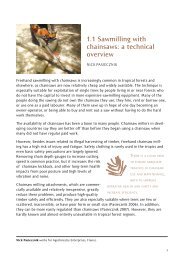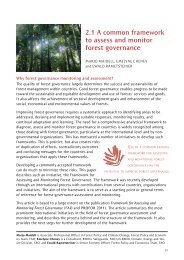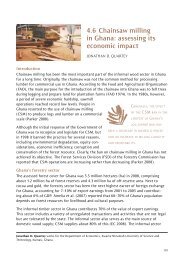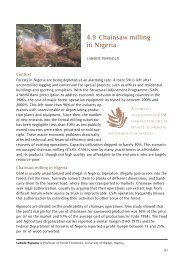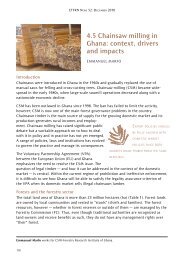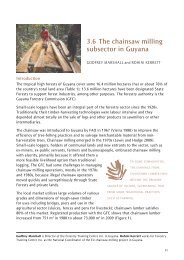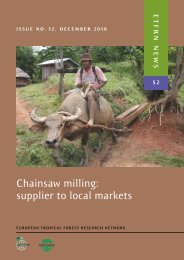Chainsaw milling: supplier to local markets - European Tropical ...
Chainsaw milling: supplier to local markets - European Tropical ...
Chainsaw milling: supplier to local markets - European Tropical ...
Create successful ePaper yourself
Turn your PDF publications into a flip-book with our unique Google optimized e-Paper software.
4.7 chaiNsaw milliNg iN kENya<br />
The sawmill industry: processors of the wood<br />
The first sawmill in kenya was set up in 1913 (Table 1). The number of sawmills increased<br />
steadily, <strong>to</strong> about ten in 1920. The second notable increase in the number of sawmills <strong>to</strong>ok<br />
place during world war ii (1939–45), and was attributed <strong>to</strong> the high demand for<br />
timber for the construction of army barracks and railway sleepers for both <strong>local</strong> and<br />
export <strong>markets</strong> (mEnr 1972). another increase occurred just after the war, mainly <strong>to</strong><br />
produce timber for reconstruction work. The mau mau rebellion of 1952–60 and the years<br />
before independence in 1963 resulted in a sharp decrease in the number of sawmills due<br />
<strong>to</strong> uncertainties about the future of the country. many british sawmill owners left the<br />
country at this time.<br />
The sawmill industry experienced its greatest growth between 1965 and 1970, due <strong>to</strong> the<br />
establishment of the africanization programme and the investment Credit Development<br />
Corporation (iCDC) by the government shortly after independence. iCDC financed the<br />
purchase of existing sawmills and the start-up of new ones with african participation.<br />
The rebate on royalties for export timber was also highest (50%) during this period, which<br />
encouraged many sawmillers <strong>to</strong> export timber, especially hardwoods.<br />
Table 1. Number of sawmills in kenya, 1913–94<br />
year number of sawmills remarks<br />
inside forest outside forest <strong>to</strong>tal<br />
1913–15 1 — 1 operating under special concessions<br />
1920 10 mainly providing timber for<br />
consumption of <strong>local</strong> settlers<br />
1940 >20 — >20 timber export <strong>markets</strong> open up<br />
1945–50 60 — 60 during and after world war ii<br />
1960–64 34 — 34 mau mau rebellion and independence<br />
struggle<br />
1970 200 150 350 africanization programme<br />
1980–85 220 150 370 ban on exports of all indigenous<br />
timber (1985)<br />
1990 — 361 361 government regulation <strong>to</strong> remove<br />
sawmills from inside the forests<br />
1994 — 450 450<br />
1999 — 450 450 ban on all operations on state<br />
plantations<br />
source: mnr annual reports, 1964–99<br />
167



